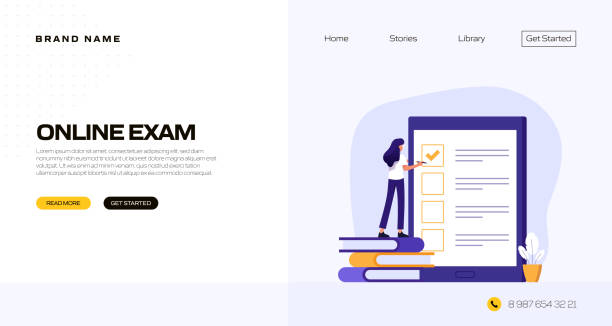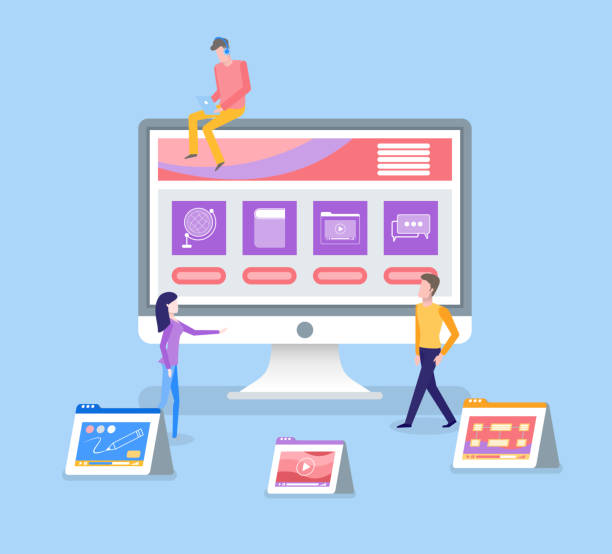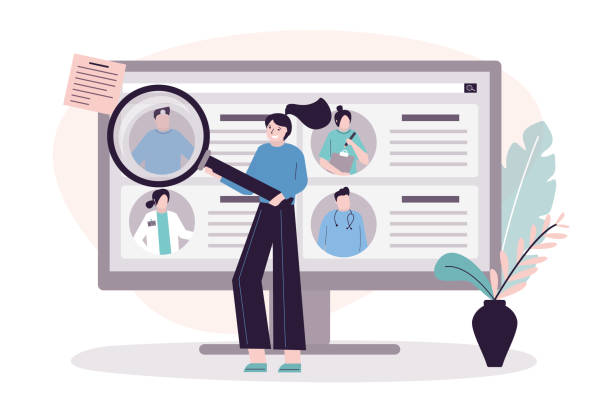The Anatomy of a User-Friendly Website Design and Its Success Factors

User-friendly website design means creating a website that users can easily interact with, find the information they need, and complete their tasks without any obstacles.
This concept goes beyond mere visual appeal and includes factors such as #ease_of_use, #efficiency, and #user_satisfaction.
A well-designed website not only has a pleasant appearance but also provides a seamless and enjoyable user experience (UX).
The main goal of user-friendly website design is to reduce friction and increase conversion rates.
A non-user-friendly website can lead to high bounce rates, decreased engagement, and ultimately, customer loss.
Therefore, investing in this area is not just a luxury choice but a strategic necessity for any online business.
Next, we will delve deeper into the key principles and components in this field.
This is an educational and vital topic for every developer and online business owner.
A proper understanding of these principles will help you build a website that not only attracts users but also retains them and achieves your business goals.
Are you concerned about your e-commerce website’s low conversion rate and not achieving your desired sales?
Rasaweb is your specialized solution for having a successful e-commerce website.
✅ Significant increase in conversion rates and sales
✅ Professional and user-friendly design to satisfy customers
⚡ Ready for a transformation in online sales? Get a free consultation!
Key Principles of User Experience (UX) in Web Design

User experience is the backbone of a user-friendly website design.
These principles include ease of navigation, consistency, and appropriate user feedback.
Intuitive navigation means that the user can find their way around the website without confusion.
Clear menus, recognizable links, and a logical page structure are of high importance.
Consistency also means uniformity in design, fonts, colors, and layout across all website pages.
This uniformity helps the user feel familiar and in control.
Appropriate feedback includes confirmation, error, or progress messages that inform the user what is happening or if their operation has been successful.
For example, when submitting a form, a success message or clear explanations in case of an error should be provided.
These principles are the foundation for creating smooth interaction and an analytical understanding of user behavior, allowing you to identify and resolve potential shortcomings.
In fact, every part of user-friendly website design is intertwined with user experience, and ignoring it can lead to project failure.
The Impact of Visual Design on User Engagement and Loyalty

Visual design plays a crucial role in attracting and retaining users.
Aesthetics, readability, and branding are the main elements of this part of user-friendly website design.
Colors, fonts, images, and the overall page layout should all be chosen not only to be attractive but also to clearly convey the brand message and improve content readability.
A cluttered or unprofessional visual design can quickly discourage users.
The use of adequate whitespace, sufficient contrast between text and background, and visual hierarchy to highlight important information are among the key points.
Strong branding, through consistent use of the logo, corporate colors, and specific writing tone, conveys a sense of trust and professionalism.
This aspect of design is not only an explanation of your visual identity but can also be entertaining and encourage users to explore further.
Below is a table of visual elements and their impact on user experience:
| Visual Element | Impact on UX | Key Point in User-Friendly Website Design |
|---|---|---|
| Colors | Evoking emotions, creating distinction, guiding the user | Using a harmonious and brand-appropriate color palette; paying attention to color psychology |
| Fonts (Typography) | Readability, visual identity, conveying emotion/feeling | Choosing readable fonts; adhering to font hierarchy for titles and text |
| Images and Videos | Attracting attention, visually explaining concepts, increasing engagement | High quality, relevant to content, optimized for loading speed |
| Whitespace | Increasing readability, reducing clutter, focusing on important elements | Generous use of whitespace for design breathing room |
Content Strategy for Deep User Engagement

Content is king; this statement especially holds true for user-friendly website design.
Your content should be clear, concise, valuable, and relevant to the audience’s needs.
Long and aimless content can tire users, while concise and useful content encourages them to explore further.
Using engaging titles, short paragraphs, lists, and relevant images significantly increases content readability.
Furthermore, your website content should answer user questions and provide them with real value.
A strong content strategy includes keyword research, SEO-driven content creation, and regular information updates.
This approach ensures that users not only find the content they need but also enjoy it and return for more information.
Your content can be news-oriented, specialized, or even thought-provoking to stimulate discussion and engagement.
Remember that every word and every image on your website should have a purpose and contribute to the user experience.
For more information on content strategy, you can refer to reputable articles on content marketing.
Are your e-commerce website visitors leaving before making a purchase? Don’t worry anymore! With Rasaweb’s professional e-commerce website design services, permanently solve the problem of not converting visitors into customers!
✅ Significant increase in conversion rates and sales
✅ Unparalleled and engaging user experience
⚡ Contact us now for a free consultation!
The Importance of Responsiveness and Mobile-First Approach in Modern Design

In today’s world, users access the internet from various devices; from smartphones and tablets to laptops and desktops.
Therefore, user-friendly website design is highly dependent on Responsiveness (Responsive Design).
A responsive website automatically adjusts its layout and elements to the user’s screen size, providing an optimal experience on any device.
The Mobile-First approach also means that the website design and development process begins first for the smallest screen (mobile) and then scales up to larger devices.
This approach ensures that the core functionality and content are well-accessible on mobile devices, which constitute the majority of users.
Ignoring this aspect can lead to losing a large portion of the audience, as users expect websites to work well on any device.
This is a very important guidance on the path to building a modern and successful website.
Given the increasing use of mobile for web browsing, this part of user-friendly website design is no longer an option but an undeniable necessity.
Usability Testing and Continuous Feedback Loop

To ensure that user-friendly website design is truly functional, conducting Usability Testing is essential.
These tests help you observe how real users interact with your website and identify strengths and weaknesses.
Collecting feedback from users, whether through surveys, interviews, or direct observation, provides valuable insights that may have been overlooked in the initial design phases.
A continuous feedback loop means that you regularly update and improve your website based on the feedback received.
This process is iterative and ongoing, allowing you to synchronize your website with changing user needs and expectations.
This specialized and data-driven approach ensures that your website is not only user-friendly initially but also maintains and even improves this quality over time.
For example, you can use tools like Hotjar or UserTesting to collect visual feedback and observe user behavior.
Accessibility for All Users: Inclusive Design

Accessibility means designing a website that is usable by everyone, including those with disabilities.
This includes individuals with visual, auditory, motor, or cognitive impairments.
User-friendly website design that adheres to accessibility principles ensures that no user is deprived of access to information or services due to physical or technological limitations.
Using alternative text for images, captions for videos, keyboard navigation, and appropriate color contrast are just some of the actions that should be considered.
This aspect of design is not only ethically correct but can also expand your target market.
WCAG (Web Content Accessibility Guidelines) are an excellent resource for learning and implementing these principles.
Ignoring accessibility not only means losing market potential but can also have legal consequences.
This is a comprehensive guidance to ensure the inclusivity of your website.
Below is a table of important accessibility considerations for user-friendly website design:
| Accessibility Consideration | Importance | Example/How to Implement in User-Friendly Website Design |
|---|---|---|
| Alternative Text (Alt Text) for Images | For blind users and search engines | Brief and accurate description of the image content |
| Keyboard Navigation | For users with motor disabilities | Ensuring all interactive elements are accessible with the Tab key |
| Sufficient Color Contrast | For users with low vision and color blindness | Using a high contrast ratio between text and background |
| Captions and Transcripts for Audio/Visual Content | For deaf and hard-of-hearing users | Providing full text of dialogues and audio descriptions |
Performance Optimization and Loading Speed

Website loading speed is one of the most important factors in user-friendly website design.
Today’s users expect websites to load quickly, and even a few seconds’ delay can lead to losing them.
Image optimization, code compression (HTML, CSS, JavaScript), use of CDN (Content Delivery Network), and caching are among the key methods to increase loading speed.
A website that loads quickly not only provides a better user experience but also performs better in search engine rankings (SEO).
This aspect of web design can directly impact conversion rates and business profitability.
A slow website frustrates users and drives them towards your competitors.
This is a specialized topic that requires technical knowledge, but its results are crucial for user-friendly website design.
Tools like Google PageSpeed Insights can help you identify speed bottlenecks and provide precise guidance for improvement.
Are you falling behind in competition with large online stores?
Rasaweb, with professional e-commerce website design, brings your business online and increases your market share!
✅ Increased brand credibility and customer trust
✅ Easy shopping experience leading to more sales
⚡ Act now to receive a free website design consultation!
Future Trends in User-Friendly Website Design

The world of the web is constantly changing and evolving, and user-friendly website design is no exception.
Future trends include Artificial Intelligence (AI) for personalizing user experience, Voice User Interfaces (Voice UI), Augmented Reality (AR) and Virtual Reality (VR), and also Privacy-First Design.
AI can analyze user behavior to provide personalized content and recommendations that significantly increase engagement.
Voice user interfaces allow users to interact with websites using voice commands, which can be more convenient for many.
Augmented and virtual reality also have high potential for providing immersive and entertaining experiences, especially in areas like online shopping or education.
Simultaneously, with increasing concerns about data privacy, designing websites with an approach that prioritizes user data protection is gaining increasing importance.
Awareness of these trends and readiness to integrate them into user-friendly website design is the key to future success and can become a thought-provoking content that sets the path for innovation.
Conclusion and Practical Steps for User-Friendly Website Design

Ultimately, user-friendly website design is a long-term investment that will yield tangible results.
From basic UX and UI principles to performance optimization and accessibility, every aspect of web design should be done considering user needs and expectations.
Remember that your website is not only a representation of your brand but also your primary tool for interacting with your audience and customers.
By adhering to these principles, you can build a website that is not only beautiful and efficient but also helps your business grow.
Practical steps include meticulous planning, target audience research, user-focused UI and UX design, valuable content creation, continuous testing and optimization, and implementing accessibility principles.
This is a comprehensive explanation and a step-by-step guidance for achieving digital success.
By adhering to this approach, your website will become a powerful tool for achieving your business goals, and your user-friendly website design will ensure success in today’s competitive world.
Frequently Asked Questions
And other services of Rasaweb Advertising Agency in the field of advertising
Smart Marketplace: A novel service for increasing customer behavior analysis through the use of real data.
Smart Content Strategy: A novel service for increasing user engagement through the use of real data.
Smart Link Building: Designed for businesses seeking user engagement through user experience customization.
Smart Digital Branding: A combination of creativity and technology to increase website traffic through the use of real data.
Smart Sales Automation: An effective tool for online growth with the help of user experience customization.
And hundreds of other services in the fields of internet advertising, advertising consulting, and organizational solutions
Internet Advertising | Advertising Strategy | Advertorial
Resources
The Importance of User Experience in Website DesignPrinciples of Responsive DesignSEO and Its Importance for Digital Success10 Tips for Improving Website Design
? Are you ready to advance your business in the digital world? Rasaweb Afarin’s expert team, by offering comprehensive digital marketing services, including SEO-optimized website design, helps you achieve your big goals and have a powerful web presence. For consultation and to start your business’s digital transformation, contact us today.
📍 Tehran, Mirdamad Street, next to Bank Markazi, Kazeroon Jonoubi Alley, Ramin Alley, No. 6

